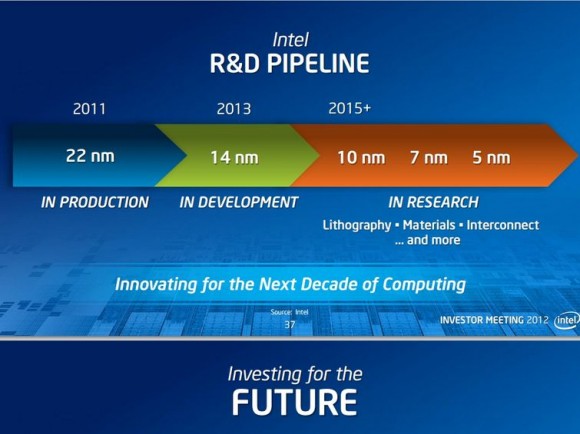Intel: By 2020 The Size of Meaningful Compute Approaches Zero
by Anand Lal Shimpi on September 10, 2012 1:29 PM EST- Posted in
- CPUs
- Intel
- Trade Shows
- IDF 2012
Intel Labs is a super interesting arm of the company, responsible for developing technologies that would potentially go into products 5 - 10 years down the road. It's from the labs that we got things like BBUL packaging (still not deployed but neat nonetheless) and the first 10GHz x86 ALUs.
Today, on the day before IDF, Intel put together a collection of demos to give us insight into what the labs folks are working on. We're still an hour away from actual demos but Intel did share a super interesting slide, pictured above.
Moore's Law and the (almost) ever shrinking transistor give us one of two things: more complexity/performance/features in a given die area, or the same performance in a steadily decreasing die area.

Exploiting the latter benefit, we have the realization above. By 2020, which assuming a 2 year cadence between process nodes means we're talking about silicon built on a 5nm process, Intel expects that the size of "meaningful compute" approaches zero. It's not totally clear what Intel defines as meaningful compute, but if you keep in mind that a single AMD Jaguar core measures < 3mm^2 at 28nm, it's not a stretch to believe that we'd have quite a bit of compute available nearly for free at 5nm. Assuming perfect scaling (not going to happen), a 100mm^2 die at 22nm would measure only 6.25mm^2 at 5nm. Even if you don't get perfect scaling, Moore's Law can give us the performance we get in a smartphone today in a size that's small enough and cheap enough to make that we can integrate it anywhere (smart-tables anyone?).
The idea of ubiquitous compute has been around for quite a while, but it's still mindblowing to think about what can happen once meaningful compute is really almost free. Remember that there's a direct relationship between the size of silicon and its cost. Today's 80 - 120mm^2 smartphone SoCs cost anywhere from $10 - $30 to integrate into a phone. If silicon with that level of complexity can be reduced in size to the point where we're looking at low single digit costs, the potential impact to new markets will be huge.
We saw what affordable compute did for smartphones, the next question is what even more affordable compute can do for other, undiscovered markets. A while ago I heard someone smart tell me that at some point displays become cheap enough where many surfaces we take for granted, start integrating them (e.g. bathroom mirrors that double as displays). Combine that with cheap compute that we can integrate everywhere as well and we have a recipe for the future.











37 Comments
View All Comments
chadwilson - Tuesday, September 11, 2012 - link
What about operations that are more integer based in performance? Using FLOPS as a measurement for performance completely ignores this segment.CaioRearte - Monday, September 10, 2012 - link
This is why solutions like Ubuntu for Android are a hint of the future of computing. Ubiquitous means processing power will be everywhere, you'll simply change which interface you use for each task.bh192012 - Monday, September 10, 2012 - link
The thing is, then we should be able to get 1/2 of smartphone power now at single digit costs, which is more than enough for a "smart table." Problem is, nobody needs or wants a smart table.Smart TV's and cheap devices to connect to dumb TV's (FXI Cotton Candy) are basically the end. The input/outputs didn't shrink. Maybe once we can print cheap touch screens on tables,fridges, walls that would be something.
Ronamadeo - Monday, September 10, 2012 - link
What does "Meaningful Compute" mean? Googling it just brings up other reports of this intel announcement. This entire article is about a phrase that was not explained.Ronamadeo - Monday, September 10, 2012 - link
What does "Meaningful Compute" mean? Googling it just brings up other reports of this intel announcement.softdrinkviking - Monday, September 10, 2012 - link
doesn't seem to be getting so cheap. yes, it's cheaper that it was, but not single-digit costs, more like 3-4 digits depending on size/quality.Death666Angel - Tuesday, September 11, 2012 - link
I can get a 24" 1920x1200 LCD monitor for 160€, 23" 1920x1080 for 110€. When I got my first 19" LCD monitor (1280x1024) it cost 450€, my first 24" LCD monitor (1920x1200) was 540€. And that is the whole package (panel, electronics, outputs...). Of course this stuff is getting super cheap and continuing to get even cheaper.softdrinkviking - Tuesday, September 11, 2012 - link
"it's cheaper than it was..."but it's going much slower than CPUs, combined with the fact that good CRTs were way better looking than any TN panel is, makes it feel kinda stagnated.
true, there have been lots of new IPS LED models out in the past 3 years or so, but they are mostly 23" and 16:9 and image is better than TN but not as good as the best IPS screens from 10 years ago.
So, what I'm saying is that, at the rate we're going now, the "bathroom mirror" display is going to be much more expensive than our cheap embedded processing unit.
And that I wish 4K IPS goodness would hurry up and come out and then get within purchasing distance. hopefully before I kick the bucket.
Azethoth - Monday, September 10, 2012 - link
Probably in our life-times. Also, one of these process nodes + denser 3d packaging means AI!Henk Poley - Tuesday, September 11, 2012 - link
Then there is this graph with current data: http://www.semiwiki.com/forum/content/1388-scaries...(Though I suspect chip manufacturing processes that are currently being rolled out to come down in price eventually)